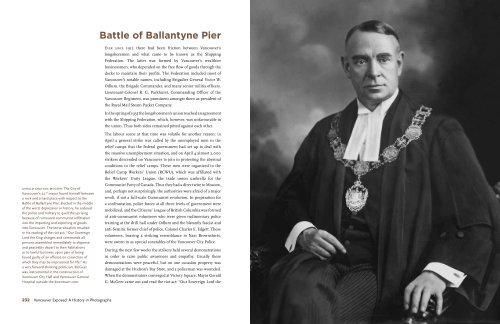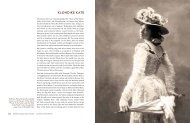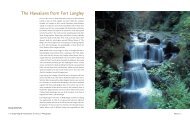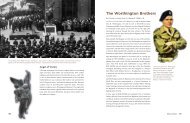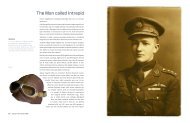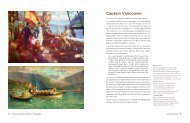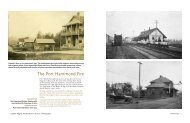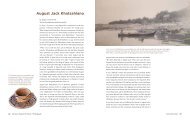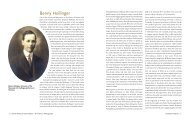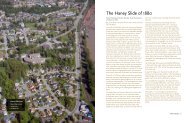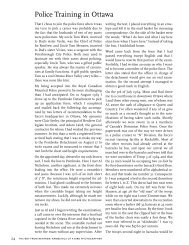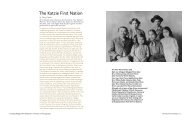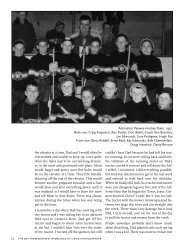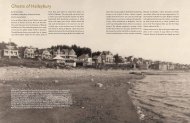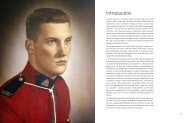Battle of Ballantyne Pier - Global Bird Photos Collection
Battle of Ballantyne Pier - Global Bird Photos Collection
Battle of Ballantyne Pier - Global Bird Photos Collection
Create successful ePaper yourself
Turn your PDF publications into a flip-book with our unique Google optimized e-Paper software.
<strong>Battle</strong> <strong>of</strong> <strong>Ballantyne</strong> <strong>Pier</strong><br />
Ever since 1912 there had been friction between Vancouver’s<br />
longshoremen and what came to be known as the Shipping<br />
Federation. The latter was formed by Vancouver’s wealthier<br />
businessmen, who depended on the free flow <strong>of</strong> goods through the<br />
docks to maintain their pr<strong>of</strong>its. The Federation included most <strong>of</strong><br />
Vancouver’s notable names, including Brigadier General Victor W.<br />
Odlum, the Brigade Commander, and many senior militia <strong>of</strong>ficers.<br />
Lieutenant-Colonel R. G. Parkhurst, Commanding Officer <strong>of</strong> the<br />
Vancouver Regiment, was prominent amongst them as president <strong>of</strong><br />
the Royal Mail Steam Packet Company.<br />
In the spring <strong>of</strong> 1935 the longshoremen’s union reached an agreement<br />
with the Shipping Federation, which, however, was unfavourable to<br />
the union. Thus both sides remained pitted against each other.<br />
gerald grattan mcgeer. The City <strong>of</strong><br />
Vancouver’s 22 nd mayor found himself between<br />
a rock and a hard place with respect to the<br />
<strong>Battle</strong> <strong>of</strong> <strong>Ballantyne</strong> <strong>Pier</strong>. Elected in the middle<br />
<strong>of</strong> the worst depression in history, he ordered<br />
the police and military to quell the uprising<br />
because <strong>of</strong> rumoured communist infiltration<br />
into the importing and exporting <strong>of</strong> goods<br />
into Vancouver. The tense situation resulted<br />
in his reading <strong>of</strong> the riot act: “Our Sovereign<br />
Lord the King charges and commands all<br />
persons assembled immediately to disperse<br />
and peaceably depart to their habitations<br />
or to lawful business upon pain <strong>of</strong> being<br />
found guilty <strong>of</strong> an <strong>of</strong>fense on conviction <strong>of</strong><br />
which they may be imprisoned for life.” As<br />
a very forward-thinking politician, McGeer<br />
was instrumental in the construction <strong>of</strong><br />
Vancouver City Hall and Vancouver General<br />
Hospital outside the downtown core.<br />
The labour scene at that time was volatile for another reason: in<br />
April a general strike was called by the unemployed men in the<br />
relief camps that the federal government had set up to deal with<br />
the massive unemployment situation, and on April 4 almost 2,000<br />
strikers descended on Vancouver to join in protesting the abysmal<br />
conditions in the relief camps. These men were organized in the<br />
Relief Camp Workers’ Union (RCWU), which was affiliated with<br />
the Workers’ Unity League, the trade union umbrella for the<br />
Communist Party <strong>of</strong> Canada. Thus they had a direct wire to Moscow,<br />
and, perhaps not surprisingly, the authorities were afraid <strong>of</strong> a major<br />
revolt, if not a full-scale Communist revolution. In preparation for<br />
a confrontation, police forces at all three levels <strong>of</strong> government were<br />
mobilized, and the Citizens’ League <strong>of</strong> British Columbia was formed<br />
<strong>of</strong> anti-communist volunteers who were given rudimentary police<br />
training at the drill hall under Odlum and the blatantly fascist and<br />
anti-Semitic former chief <strong>of</strong> police, Colonel Charles E. Edgett. These<br />
volunteers, bearing a striking resemblance to Nazi Brownshirts,<br />
were sworn in as special constables <strong>of</strong> the Vancouver City Police.<br />
During the next few weeks the strikers held several demonstrations<br />
in order to raise public awareness and empathy. Usually these<br />
demonstrations were peaceful, but on one occasion property was<br />
damaged at the Hudson’s Bay Store, and a policeman was wounded.<br />
When the demonstrators converged at Victory Square, Mayor Gerald<br />
G. McGeer came out and read the riot act: “Our Sovereign Lord the<br />
232 Vancouver Exposed: A History in Photographs The Sun Never Sets 233
The song “The Red Flag”<br />
The people's flag is deepest red,<br />
It shrouded <strong>of</strong>t our martyr'd dead<br />
And ere their limbs grew stiff and cold,<br />
Their hearts' blood dyed its ev'ry fold.<br />
Then raise the scarlet standard high,<br />
Within its shade we'll live and die,<br />
Though cowards flinch and traitors sneer,<br />
We'll keep the red flag flying here.<br />
King charges and commands all persons assembled immediately<br />
to disperse and peaceably depart to their habitations or to lawful<br />
business upon pain <strong>of</strong> being found guilty <strong>of</strong> an <strong>of</strong>fense on conviction<br />
<strong>of</strong> which they may be imprisoned for life.” He was flanked by<br />
Vancouver Police Chief Colonel William Wasborough Foster. The<br />
crowd dispersed peacefully, but the situation remained explosive.<br />
On 27 May 1935 the longshoremen at <strong>Ballantyne</strong> <strong>Pier</strong> on Burrard<br />
Inlet unilaterally took over dispatching <strong>of</strong> jobs — one <strong>of</strong> the sore<br />
points in the recent agreement with the Federation, giving the<br />
Federation the reason for a lock-out. The Federation brought in<br />
untrained replacement workers, so-called scabs, and mobilized<br />
police forces to prevent the locked out workers from picketing.<br />
Meanwhile the unemployed longshoremen joined the relief camp<br />
at Hastings Park. The spiritually and physically broken men didn’t<br />
have as much as the nickel required for the tram ride to <strong>Ballantyne</strong><br />
<strong>Pier</strong>. Many walked from the relief camp to the pier, stood around all<br />
day, only to return back to the camp at night and missing out on a<br />
much needed meal, as the rule was that anyone leaving the camp in<br />
search for a job would not be let back in.<br />
However, a short while after the lock-out started the relief camp<br />
workers left town on their famous On-to-Ottawa Trek. Still, it was<br />
a crowd <strong>of</strong> 1,000 protesters, consisting <strong>of</strong> locked out workers and<br />
their supporters, who marched toward the Heatley Street entrance<br />
to <strong>Ballantyne</strong> <strong>Pier</strong> on June 18 in order to “talk to the scabs.”<br />
Leading the protesters was Victoria Cross recipient Mickey<br />
O’Rourke, a pacifist who had been a stretcher-bearer while serving<br />
overseas during the First World War. After being awarded his medal<br />
in November 1917 at a ceremony Buckingham Palace, O’Rourke<br />
sailed to the west coast <strong>of</strong> the United States and was engaged in<br />
public speaking to crowds <strong>of</strong>ten in the thousands to raise money<br />
for War Bonds. After his discharge, he suffered from post-traumatic<br />
stress disorder. He also had emphysema from being gassed, and by<br />
1920 he was seeing doctors in Shaughnessy Veterans’ Hospital in<br />
Vancouver with a nervous condition that severely affected his ability<br />
to hold onto jobs, although he did work on the Vancouver waterfront<br />
for many years.<br />
According to union legend, the 59-year-old O’Rourke, a well-known<br />
personality in the city, and union leader Ivan Emery led the parade<br />
in the confrontation on 18 June 1935. The aged war hero usually<br />
in the dirty thirties. <strong>Ballantyne</strong> <strong>Pier</strong> was east <strong>of</strong> the old Hastings Mill site and just west <strong>of</strong> the<br />
Rogers Sugar Refinery. The huge grain elevator, dubbed “Steven's folly,” was sandwiched between the<br />
pier and the CPR tracks. The smaller dock was called the Great Northern Railway dock.<br />
wore sun glasses due to eye infections resulting from<br />
having been gassed in the First World War but opted<br />
to loan them to Emery to conceal the union leader’s<br />
identity, as the police had him on their surveillance<br />
list. At first observers <strong>of</strong> the march believed O’Rourke<br />
was guiding a blind man with a Union Jack draped over<br />
his shoulders. The two men, with many First World<br />
War veterans marching immediately behind them, left<br />
Labour Hall and marched east one block on Hastings<br />
Street before turning north on Heatley Street towards<br />
<strong>Ballantyne</strong> <strong>Pier</strong>. O’Rourke’s presence in the procession<br />
was established by an impeccable source: the police<br />
reports. They had a clear photograph <strong>of</strong> him, standing<br />
neat and proud, recorded in their files.<br />
As the demonstrators approached the entrance, they<br />
were met by a line <strong>of</strong> Vancouver Police led by Colonel<br />
Foster, who would not let them through.<br />
Foster and O’Rourke were definitely from opposite sides<br />
<strong>of</strong> the tracks. Foster was born in England in 1875, and<br />
on coming to British Columbia immediately became<br />
involved in the lucrative lumber business before serving<br />
as a superintendant with the CPR and then as a police<br />
magistrate in Revelstoke. From 1922 to 1927 he had been<br />
the Commanding Officer <strong>of</strong> the Duke <strong>of</strong> Connaughts. At<br />
the time <strong>of</strong> the <strong>Ballantyne</strong> <strong>Pier</strong> lock-out he had just been<br />
appointed chief <strong>of</strong> the Vancouver Police Department.<br />
What was said between Foster and O’Rourke has not<br />
been recorded, but it was not cordial, as the strikers<br />
attempted to force their way through the police line.<br />
According to the Vancouver Sun newspaper, members<br />
<strong>of</strong> the Royal Canadian Mounted Police fired tear gas<br />
over the heads <strong>of</strong> the crowd. The Vancouver City Police<br />
began to use four-foot-long wooden clubs to disperse the<br />
strikers. At that point a contingent <strong>of</strong> the BC Provincial<br />
234 Vancouver Exposed: A History in Photographs The Sun Never Sets 235
Police, armed with clubs, and members <strong>of</strong> the RCMP, mounted on<br />
Memories <strong>of</strong> a Union Leader<br />
by Gordon Westrand<br />
President <strong>of</strong> the International Longshore<br />
and Warehouse Union, 1992-1996<br />
My grandfather started working at the Hastings<br />
Sawmill in 1906 as a longshoreman loading heavy<br />
timbers into confined areas into the ships. He’d<br />
come over from Sweden and was a very capable<br />
fisherman so was nicknamed “Charlie the Fish.”<br />
He had several sons by the time <strong>of</strong> the big strike<br />
in 1935. He would go out fishing all night and<br />
then do picket duty during the day. There were<br />
several incidents on the picket lines when the<br />
“goon” squad, scabs working for the Shipping<br />
Federation, either beat up or abused strikers. My<br />
uncle Carl was a semi-pr<strong>of</strong>essional boxer and<br />
sometimes he and some other men would go<br />
around and repay individuals for transgressions<br />
against some <strong>of</strong> their union members.<br />
My family was in the march that ended in the<br />
<strong>Battle</strong> for <strong>Ballantyne</strong> <strong>Pier</strong> on 18 June 1935 when the<br />
police fired tear gas at the strikers and charged<br />
them on horseback with clubs. My grandfather<br />
was clubbed down at least once. My uncle Carl<br />
was clubbed down and knocked unconscious four<br />
times. I was given reassurances that each time he<br />
left his mark with the police <strong>of</strong>ficers in question.<br />
My grandfather and uncles were all blacklisted<br />
by the employers after the strike and were<br />
unable to get work.<br />
The <strong>Battle</strong> for <strong>Ballantyne</strong> <strong>Pier</strong> was a set-up with<br />
the police and the employers provoking the<br />
confrontation. The strikers had been marching<br />
in an orderly way to talk to the scabs that were<br />
taking their jobs. I’ve been told that there were<br />
police with machine guns hidden in a flat-deck<br />
rail car at the marshalling yards at the north foot<br />
<strong>of</strong> Heatley Street. The strike had the support<br />
<strong>of</strong> the general public and several storefronts<br />
on Hastings Street had signs in the windows<br />
saying that they supported the strikers. The<br />
police fired tear gas into these grocery stores and<br />
other buildings. After the police read the riot act<br />
mounted policemen with clubs emerged from<br />
behind buildings and charged at the crowd. The<br />
strikers fled east down Powell Avenue but were<br />
prevented from escaping by police who were in<br />
hiding in police cars armed with shotguns.<br />
Many <strong>of</strong> the stories that I heard from my family<br />
never appeared in the newspapers. My father told<br />
me about having to go to the butcher shop and get<br />
discarded liver that was usually given away for dog<br />
food. He and his bothers and sisters ate the liver.<br />
My grandfather died in 1938 but my father and<br />
other family members have many fond stories<br />
about him. It’s good that he is being remembered.<br />
horses, charged into the crowd. The horsemen experienced some<br />
difficulties when some <strong>of</strong> their horses refused to cross the railwas<br />
tracks. Reinforced by the “specials,” the VCP quickly gained the<br />
upper hand, and a running battle ensued that saw the first use <strong>of</strong><br />
tear gas in Vancouver. According to some reports the police had<br />
machine guns, but they were not used. During the melee O’Rourke<br />
was said to have thrown a large brick at one mounted <strong>of</strong>ficer before<br />
being seized by an RCMP sergeant and dragged out <strong>of</strong> the fray to<br />
safety.<br />
The strikers did not back down meekly, however, and the fight<br />
lasted some three hours, spreading into the surrounding residential<br />
area, where the police on galloping horseback chased the longshore<br />
strikers and clubbed them with batons even as they were retreating.<br />
Two demonstrators received buckshot wounds in the back <strong>of</strong> the<br />
legs by a police who emerged from prowl cars armed with shotguns.<br />
Close to one hundred police and strikers were injured during the<br />
confrontation, thereafter referred to as the “<strong>Battle</strong> <strong>of</strong> <strong>Ballantyne</strong><br />
<strong>Pier</strong>.”<br />
Between 4 June and 25 October 1925 over 500 criminal cases were<br />
brought before the courts resulting in 148 convictions for assault,<br />
damage to property, trespassing, rioting, obstruction, unlawful<br />
assembly, threatening and even vagrancy. Union leader Ivan Emery<br />
was charged for inciting a riot and for counselling an unlawful<br />
assembly and sentenced to three months in jail, and one man was<br />
sentenced to three years in jail and five lashes with a cat-<strong>of</strong>-ninetails.<br />
At year’s end 18 longshoremen and seamen were serving time<br />
in Burnaby’s Oakalla Prison Farm. Mildred Dougan, a women’s<br />
auxiliary member who was charged with assaulting a police <strong>of</strong>ficer,<br />
was held in jail for six weeks before coming to trail and receiving a<br />
sentence <strong>of</strong> a $25 fine or 30 days in jail. She chose the 30 days.<br />
william wasborough foster. A Colonel<br />
with Vancouver’s prestigious Duke <strong>of</strong><br />
Connaught’s Own Rifles during the World War,<br />
this much decorated war hero became Chief<br />
Constable <strong>of</strong> the Vancouver Police Department<br />
following a corruption scandal. He had the<br />
unfortunate duty <strong>of</strong> leading riot police against<br />
longshoreman strikers during the depression<br />
years to win the “<strong>Battle</strong> <strong>of</strong> <strong>Ballantyne</strong> <strong>Pier</strong>.”<br />
a thompson model 1928a1 sub-machine gun. Guns like these were<br />
allegedly used by the Vancouver Police Department during the <strong>Battle</strong><br />
<strong>of</strong> <strong>Ballantyne</strong> <strong>Pier</strong>. These were the Tommy Guns <strong>of</strong> the same type<br />
used by gangsters such as Al Capone <strong>of</strong> Chicago in the 1920s–1930s.<br />
This .45 calibre weapon has a clip that contained 20 rounds.<br />
Though the Shipping Federation won the battle, they would<br />
eventually lose the labour war. By the 1940s working conditions<br />
had improved considerably, a strong union had developed, and the<br />
Federation eventually lost its grip on the dockyards.<br />
236 Vancouver Exposed: A History in Photographs The Sun Never Sets 237


